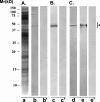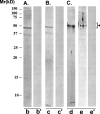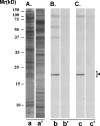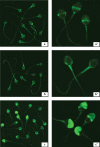Isolation of human single chain variable fragment antibodies against specific sperm antigens for immunocontraceptive development
- PMID: 18372255
- PMCID: PMC2902835
- DOI: 10.1093/humrep/den088
Isolation of human single chain variable fragment antibodies against specific sperm antigens for immunocontraceptive development
Abstract
Background: Contraceptive vaccines can provide valuable alternatives to current methods of contraception. We describe here the development of sperm-reactive human single chain variable fragment (scFv) antibodies of defined sperm specificity for immunocontraception.
Methods: Peripheral blood leukocytes (PBL) from antisperm antibody-positive immunoinfertile and vasectomized men were activated with human sperm antigens in vitro, and the complementary DNA prepared and PCR-amplified using primers based on all the variable regions of heavy and light chains of immunoglobulins. The scFv repertoire was cloned into pCANTAB5E vector to create a human scFv antibody library.
Results: Panning of the library against specific sperm antigens yielded several clones, and the four strongest reactive were selected for further analysis. These clones had novel sequences with unique complementarity-determining regions. ScFv antibodies were expressed, purified and analyzed for human sperm reactivity and effect on human sperm function. AFA-1 and FAB-7 scFv antibodies both reacted with fertilization antigen-1 antigen, but against different epitopes. YLP20 antibody reacted with the expected human sperm protein of 48 +/- 5 kDa. The fourth antibody, AS16, reacted with an 18 kDa sperm protein and seems to be a human homologue of the mouse monoclonal recombinant antisperm antibody that causes sperm agglutination. All these antibodies inhibited human sperm function.
Conclusions: This is the first study to report the use of phage display technology to obtain antisperm scFv antibodies of defined antigen specificity. These antibodies will find clinical applications in the development of novel immunocontraceptives, and specific diagnostics for immunoinfertility.
Figures










Similar articles
-
Development of genetically engineered human sperm immunocontraceptives.J Reprod Immunol. 2009 Dec;83(1-2):145-50. doi: 10.1016/j.jri.2009.06.260. Epub 2009 Oct 23. J Reprod Immunol. 2009. PMID: 19853924 Free PMC article. Review.
-
Antisperm contraceptive vaccines: where we are and where we are going?Am J Reprod Immunol. 2011 Jul;66(1):5-12. doi: 10.1111/j.1600-0897.2011.01000.x. Epub 2011 Apr 11. Am J Reprod Immunol. 2011. PMID: 21481057 Free PMC article. Review.
-
Status of contraceptive vaccines.Am J Reprod Immunol. 2009 Jan;61(1):11-8. doi: 10.1111/j.1600-0897.2008.00663.x. Am J Reprod Immunol. 2009. PMID: 19086987 Free PMC article. Review.
-
[Preparation of human phage antibodies specific for SSA/Ro antigen and its sequence analysis].Zhonghua Yi Xue Za Zhi. 2004 Nov 17;84(22):1904-8. Zhonghua Yi Xue Za Zhi. 2004. PMID: 15631804 Chinese.
-
Production and characterization of a human antisperm monoclonal antibody against CD52g for topical contraception in women.EBioMedicine. 2021 Jul;69:103478. doi: 10.1016/j.ebiom.2021.103478. Epub 2021 Jul 10. EBioMedicine. 2021. PMID: 34256345 Free PMC article.
Cited by
-
The Effect of Curcumin on Intracellular pH (pHi), Membrane Hyperpolarization and Sperm Motility.J Reprod Infertil. 2014 Apr;15(2):62-70. J Reprod Infertil. 2014. PMID: 24918078 Free PMC article.
-
Immunocontraception: Filamentous Bacteriophage as a Platform for Vaccine Development.Curr Med Chem. 2017 Nov 20;24(35):3907-3920. doi: 10.2174/0929867324666170911160426. Curr Med Chem. 2017. PMID: 28901276 Free PMC article. Review.
-
Development of genetically engineered human sperm immunocontraceptives.J Reprod Immunol. 2009 Dec;83(1-2):145-50. doi: 10.1016/j.jri.2009.06.260. Epub 2009 Oct 23. J Reprod Immunol. 2009. PMID: 19853924 Free PMC article. Review.
-
Antisperm contraceptive vaccines: where we are and where we are going?Am J Reprod Immunol. 2011 Jul;66(1):5-12. doi: 10.1111/j.1600-0897.2011.01000.x. Epub 2011 Apr 11. Am J Reprod Immunol. 2011. PMID: 21481057 Free PMC article. Review.
-
Canine and feline pregnancy loss due to viral and non-infectious causes: a review.Theriogenology. 2008 Aug;70(3):304-19. doi: 10.1016/j.theriogenology.2008.05.035. Epub 2008 Jun 10. Theriogenology. 2008. PMID: 18547635 Free PMC article. Review.
References
-
- Arndt KM, Muller KM, Pluckthun A. Factors influencing the dimer to monomer transition of an antibody single-chain Fv fragment. Biochemistry. 1998;37:12918–12926. - PubMed
-
- Bohring C, Krause W. Immune infertility: towards a better understanding of sperm (auto)-immunity. The value of proteomic analysis. Hum Reprod. 2003;18:915–924. - PubMed
-
- Byrd W, Tsu J, Wolf D. Kinetics of spontaneous and induced acrosomal loss in human sperm incubated under capacitating and noncapacitating conditions. Gamete Res. 1989;22:109–122. - PubMed
-
- Casadevall A. Passive antibody therapies: progress and continuing challenges. Clin Immunol. 1999;93:5–15. - PubMed
-
- Chapman AP. PEGylated antibodies and antibody fragments for improved therapy: a review. Adv Drug Deliv Rev. 2002;54:531–545. - PubMed
Publication types
MeSH terms
Substances
Grants and funding
LinkOut - more resources
Full Text Sources
Other Literature Sources

